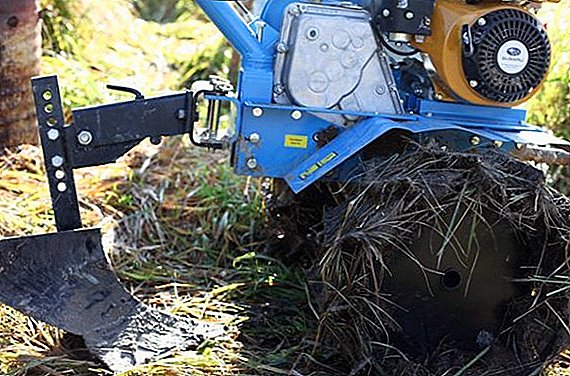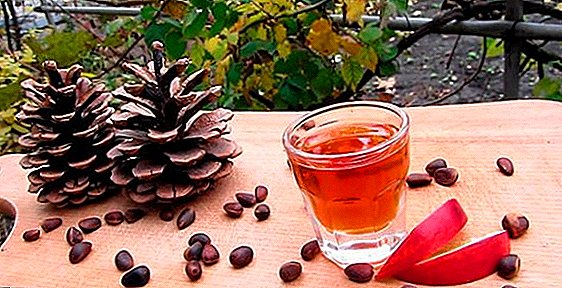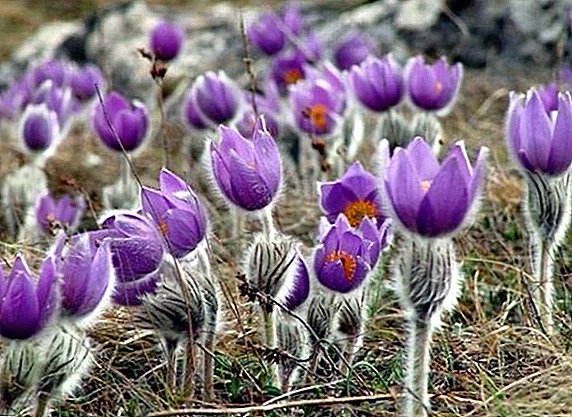 In our nature there is such an interesting and amazing plant as a cross-chamber. When the snow has not yet descended, you can see unusual violet-lilac flowers resembling ordinary tulips on the rails. The stalks and leaves of this miracle are covered with fuzz, and the yellow middle part attracts the eye. Due to the early appearance, the people, these flowers are called "snowdrops".
In our nature there is such an interesting and amazing plant as a cross-chamber. When the snow has not yet descended, you can see unusual violet-lilac flowers resembling ordinary tulips on the rails. The stalks and leaves of this miracle are covered with fuzz, and the yellow middle part attracts the eye. Due to the early appearance, the people, these flowers are called "snowdrops".
Lumbago, or sleep-grass, is common in the Northern Hemisphere and has about 40 species, some of which are listed in the Red Book.
Did you know? People believed that evil is afraid of sleep-grass and runs away from it. It helps, according to popular belief, from damage and the evil eye, and if you carry grass with you, you can protect yourself from all kinds of misfortunes and evil wiles.
Alpine
The Latin name of this chamber is Рulsatilla Alpina. It grows up to 20 cm in height, blooms from May to August with white, cream or yellow delicate flowers.  It differs from the rest of the lumbago of lesser symmetry of the inflorescence and a large variety of petal shapes. There are several varieties of the Alpine space, which are found only in the Alpine belt in the territory of Central and Eastern Europe, but the highlands of Southern and Central Europe are considered to be their homelands.
It differs from the rest of the lumbago of lesser symmetry of the inflorescence and a large variety of petal shapes. There are several varieties of the Alpine space, which are found only in the Alpine belt in the territory of Central and Eastern Europe, but the highlands of Southern and Central Europe are considered to be their homelands.
Important! Sleep-grass is not the best way to tolerate transplantation, so you need to seat it as soon as the first leaves appear. Since these plants belong to the early spring, they should be planted in separate groups closer to the path. Perfect neighbors - Crocus and primroses.
Spring
Рulsatilla Vernalis - so in Latin is called this kind of lumbago. On the territory of the Russian Federation, in the wild, it is found only on the Karelian Isthmus (Leningrad Region), in the south-west of Karelia and on the north-west coast of Lake Ladoga.
Mainly distributed just north of the Primorsk-Michurinskoe-Otradnoe line. South can be found only in some places (Orekhovo, Lembolovo, Kannelyarvi).  Outside the Russian Federation, the spring chamber in natural conditions grows in the mountains of Central Europe (Alps, Pyrenees), in the east of the Central European Plain, in the north of Jutland, south-west of Finland, in the southern part of the Scandinavian Peninsula.
Outside the Russian Federation, the spring chamber in natural conditions grows in the mountains of Central Europe (Alps, Pyrenees), in the east of the Central European Plain, in the north of Jutland, south-west of Finland, in the southern part of the Scandinavian Peninsula.
Spring chamber - a plant up to 30 cm tall, with slightly curved stems. Leaves - trifoliate, appear after flowering. Flowers solitary, up to 4 cm in diameter, inside - white, on top - light purple. Blooming in the form of bells in the second decade of May. The flowering period - 20-25 days.
Under natural conditions, this flower loves a grassy sunny hill and pine forests. It practically does not give in to cultivation, prefers an acidic soil with sand and coniferous bedding. If there are coniferous trees on the land plot, this kind of lumbago flower is recommended to be planted under rare pines.
The plant is easily propagated by seeds and begins to bloom in the sixth or eighth year of life. It has a sufficient level of winter hardiness and calmly transfers temperatures to -32 ºC.
Mountain
This type of lumbago (Latin - Pulsatilla Montana), as well as the Alpine, belongs to the alpine plants. The flowering period is 30 days, and the beginning of flowering falls on the first half of May.  Differs densely pubescent bells of dark purple color and velvety pinnately dissected leaves. Does not grow above 20 cm.
Differs densely pubescent bells of dark purple color and velvety pinnately dissected leaves. Does not grow above 20 cm.
Under natural conditions, it grows in Central and Eastern Europe, in the highlands.
Did you know? Lumbago amaze gardeners with their amazing quality. - variability. They easily hybridize, and new specimens may appear on the site.
Golden
Sunny Pulsatilla Aurea always seems larger than its size. Growing up to 35 cm, it is distinguished by bright, fluffy, dissected leaves and long petioles. However, bright greens are only the background for the magnificent six-centimeter flowers of bright golden color. Golden chamber blossoms in June, being the forerunner of hot pores. At the same time, both flowers and greens are revealed at the same time.  Lumbago golden conquers with its beauty, especially in those places where it grows in natural conditions (in the Caucasus).
Lumbago golden conquers with its beauty, especially in those places where it grows in natural conditions (in the Caucasus).
Important! Any kind of sleep-grass is poisonous, so you should be careful not to get its juice on the skin. It can cause irritation and burns, but in the dried form the cross-chamber loses its toxic properties.
Bell-shaped
The Latin name of this most original chamber is Pulsatilla Campanella. Although he looks and looks like an ordinary bell, but his flowers are more elongated, slightly tilted and look down. Reaching only 2.5 cm in diameter, they look very effective due to their graceful form and delicate, light blue color.  Flowering chamber blooms in April and May. The leaves are deeply dissected and very bright.
Flowering chamber blooms in April and May. The leaves are deeply dissected and very bright.
Under natural conditions, the upper part of the forest belt predominantly subalpine and alpine meadows.
Crimean
This charming baby has a different name - Haller's chamber (Latin - Pulsatilla Halleri). In the wild, it lives in the Crimea on treeless plate-like tops, in rock crevices, in meadows and in Central Europe.  When this dream blooms grass, it is simply impossible to tear off a look from it. In late April - early May, the Crimean chamber is highlighted by shaggy, bright purple flowers with a lush yellow heart and tall leaves reaching for the sun, bright leaves.
When this dream blooms grass, it is simply impossible to tear off a look from it. In late April - early May, the Crimean chamber is highlighted by shaggy, bright purple flowers with a lush yellow heart and tall leaves reaching for the sun, bright leaves.
Meadow
This type of lumbago, whose Latin name is Pulsatilla Pratensis, is characterized by flowers of subdued-purple shade drooping on gracefully curving peduncles up to 5 cm in diameter. just touches. Begins to bloom in late April and pleases the eye for 20-30 days.  The most popular form of Lugovoy lumbago Nigricans will amaze you with a rich inky-purple color.
The most popular form of Lugovoy lumbago Nigricans will amaze you with a rich inky-purple color.
The meadow of the meadow, whose height reaches 30 cm, is naturally found in pine forests and on the dry slopes of the forest zone.
Important! Of all the snowdrop family of buttercups, the Lugovoy backache is the most poisonous. Its juice on the skin causes it to blister, and ingestion is fraught with inflammation of the gastrointestinal tract, kidneys, and can even paralyze breathing.
Ordinary
The shoots of this species grow to 20 cm and are crowned with single flowers of bell-shaped form with amazing pointed petals that bloom to cut leaves.  Lumbago Ordinary - the most diverse form, a description of the forms of which may take several pages. Therefore, now we will mark only the best varieties:
Lumbago Ordinary - the most diverse form, a description of the forms of which may take several pages. Therefore, now we will mark only the best varieties:
- Amoena - characterized by dark, red-purple large flowers and early flowering;
- Atrosanguinea - differs red drooping flowers and thin foliage;
- Grandis - decorated with large (up to 8 cm in diameter) flowers;
- Mrs van der Elst - variety with pale pink flowers;
- Papageno - subspecies with large white flowers and dissected petals;
- Papageno Black - characterized by the colors of a bright lilac color;
- Rote Glocke is a red tulip variety.
Disclosed
Lumbar Opened (lat. - Pulsatilla Patens) - the main competitor of the Common Orb. Very diverse in height (7-50 cm) and in color of flowers. The leaves appear immediately after flowering and are finger-shaped.  The flowers are white, bright lilac or blue-violet, completely correspond to the name - their diameter reaches 8 cm. At the beginning, the usual form of the bell changes to an open star-shaped calyx. Since the flower looks up, you can easily see all its details.
The flowers are white, bright lilac or blue-violet, completely correspond to the name - their diameter reaches 8 cm. At the beginning, the usual form of the bell changes to an open star-shaped calyx. Since the flower looks up, you can easily see all its details.
It blooms in April and May, releasing up to 50 flowers on a bush.
In the wild, the lumbago chamber Opened has a wide range of growth: the European territory of Russia, Western Siberia, Central and Western Europe. It is found in moderately wet and dry places on poor and rich soils, however, it is sensitive to light.
Reproduces backache seedling, but also known cases of vegetative reproduction.
Doubtful
The Chamber of Doubtful (Pulsatilla Ambigua), wherever it occurs, is distinguished by a blue, saturated ultramarine color. Elegant splayed bells have a small size (only 2 cm), but at the same time they look very beautiful. They wilt in the buds, and, gradually rising, open up. It blooms in late April in the forest zone and in late May-early June in the highlands.  The leaves are dissected, form a rosette of 30 cm in diameter, emphasizing the peduncles. Natural habitat zone - Siberia and Mongolia.
The leaves are dissected, form a rosette of 30 cm in diameter, emphasizing the peduncles. Natural habitat zone - Siberia and Mongolia.
Did you know? Herders use the urchin Doubtful as an early spring feed that helps to quickly restore the weakened strength of domestic animals.Seeing at least once backache during the flowering period, you will forever be fascinated by their beauty, because in the world it is difficult to find a more touching phenomenon of an awakening nature. Unfortunately, some types of sleep-herbs are listed in the Red Book and are found less and less today.












